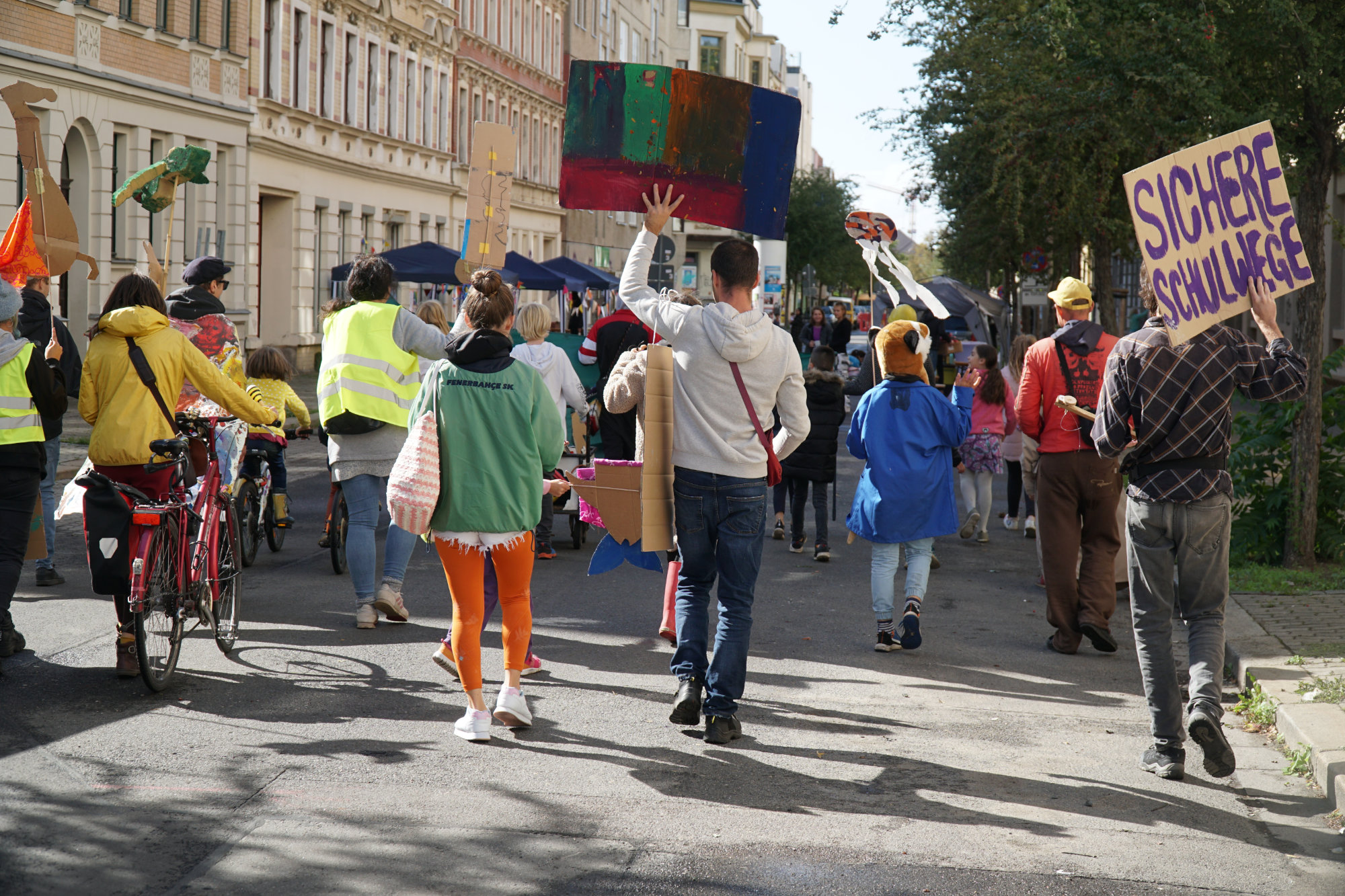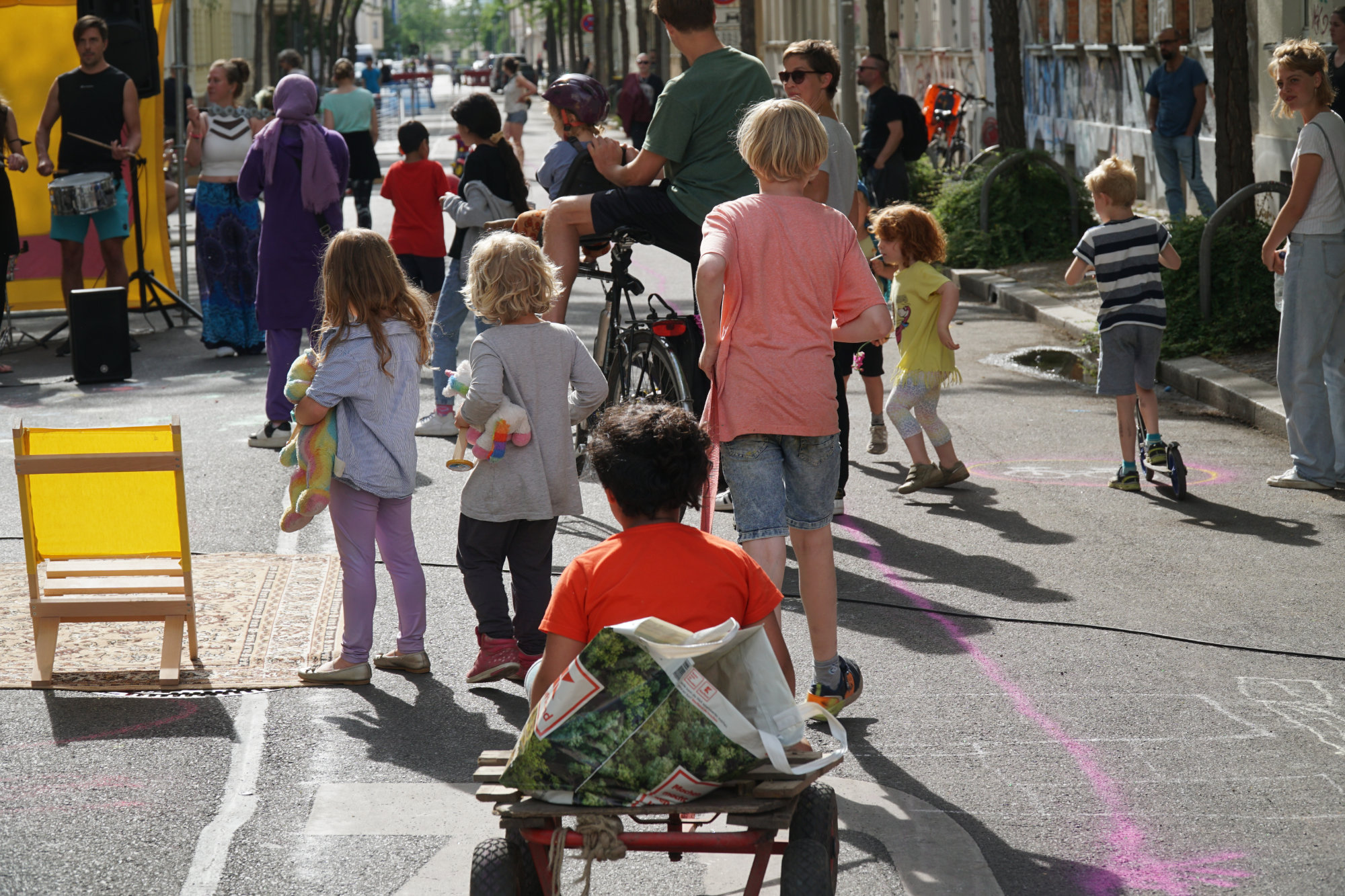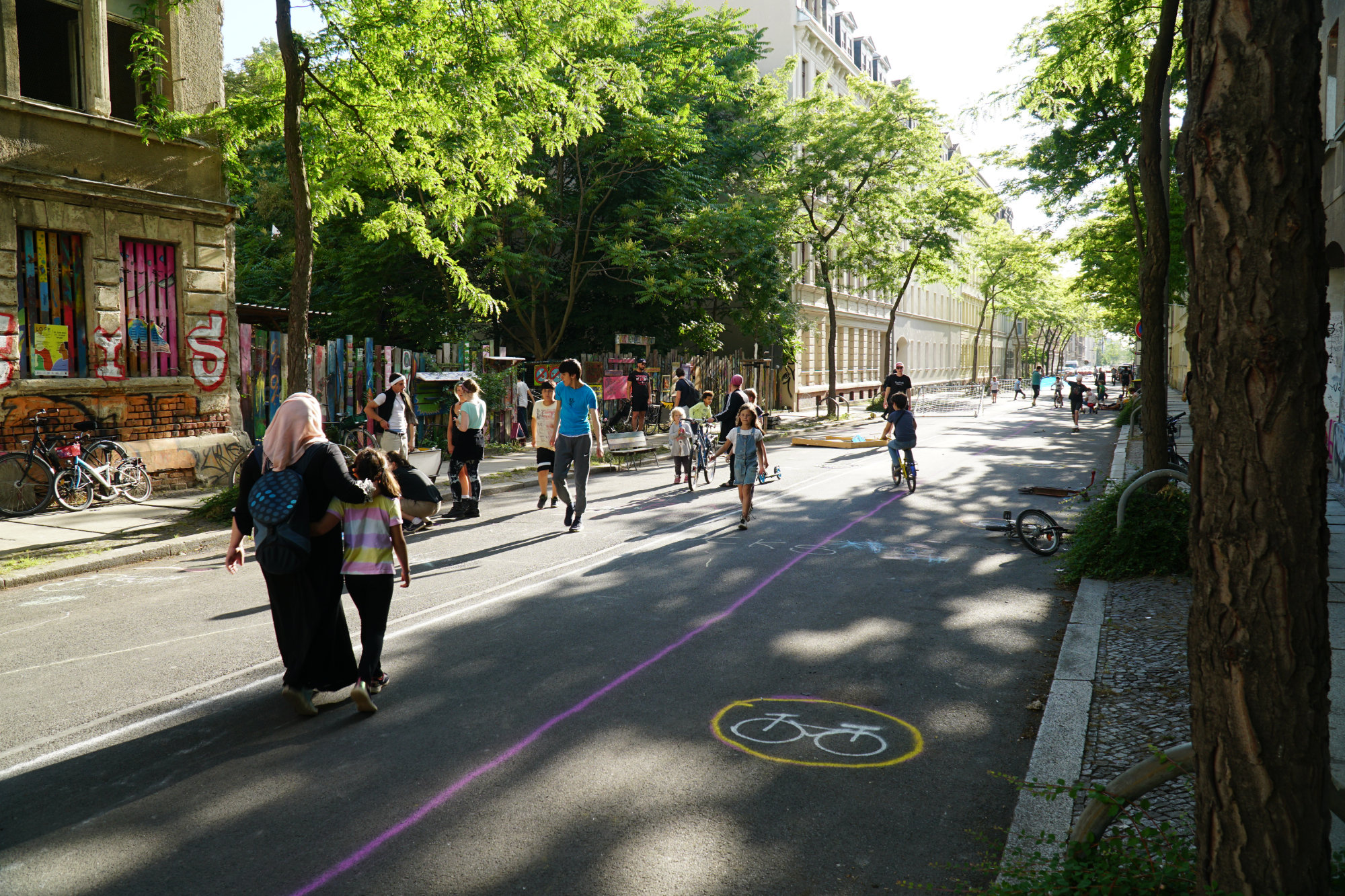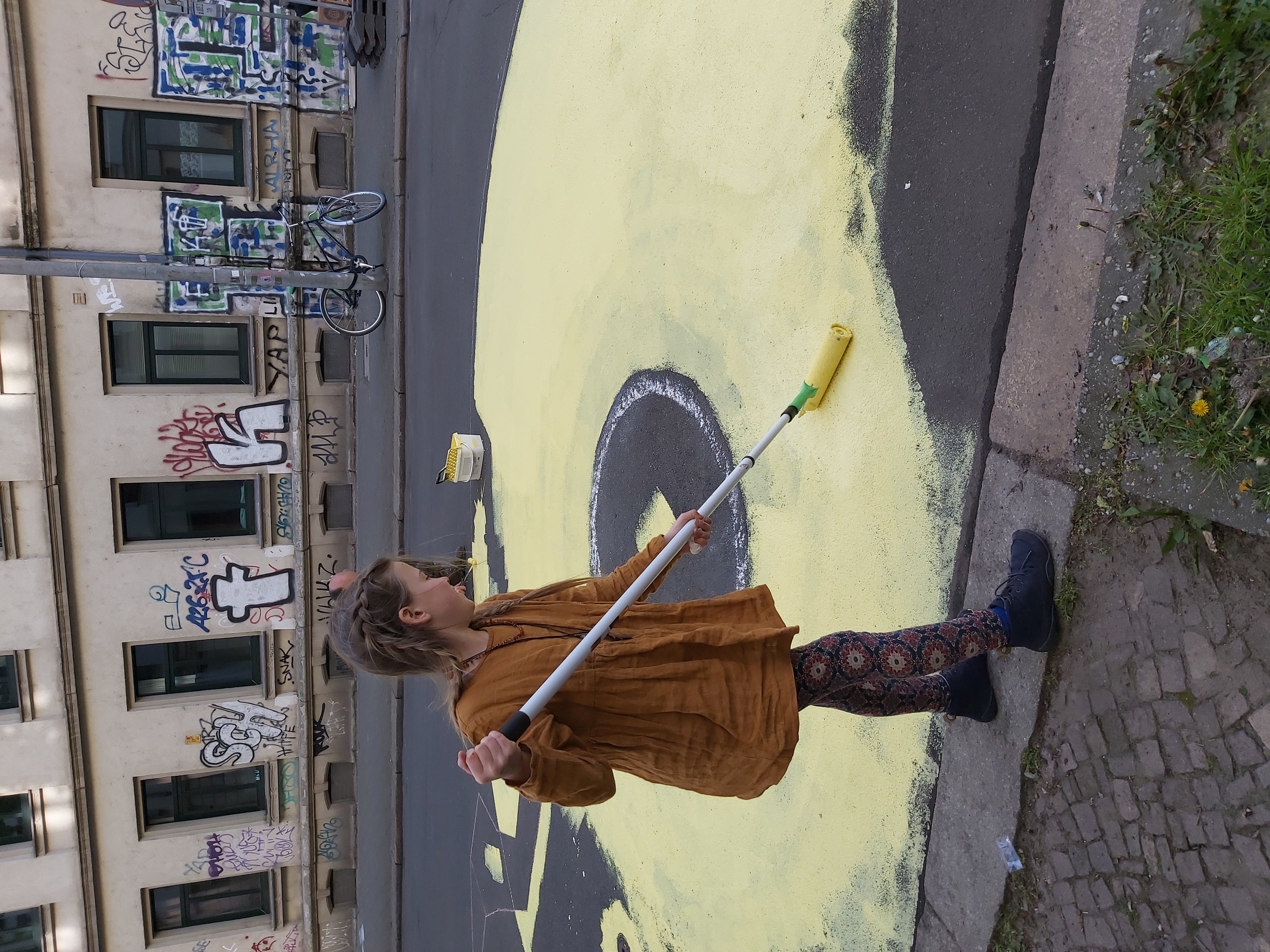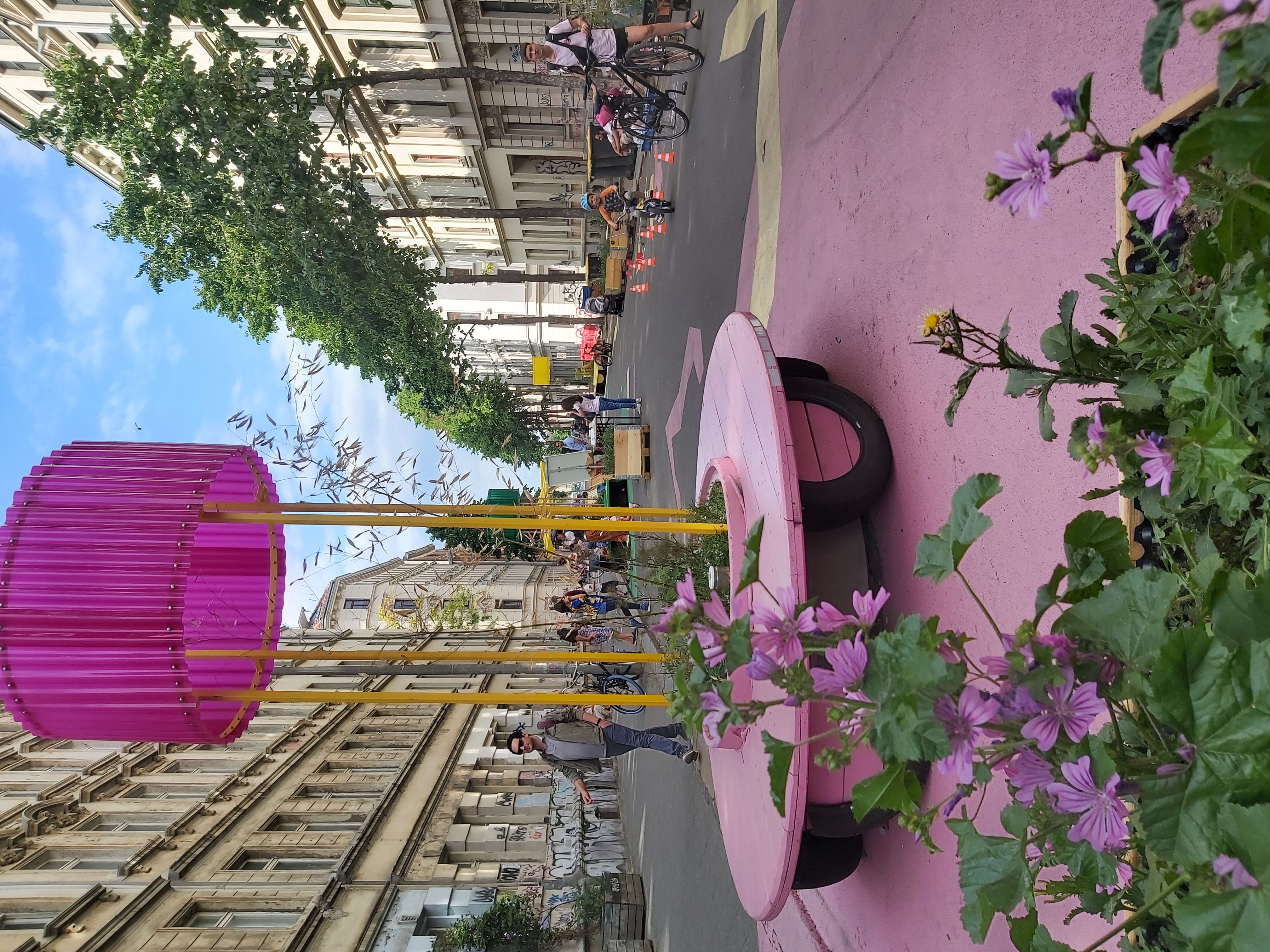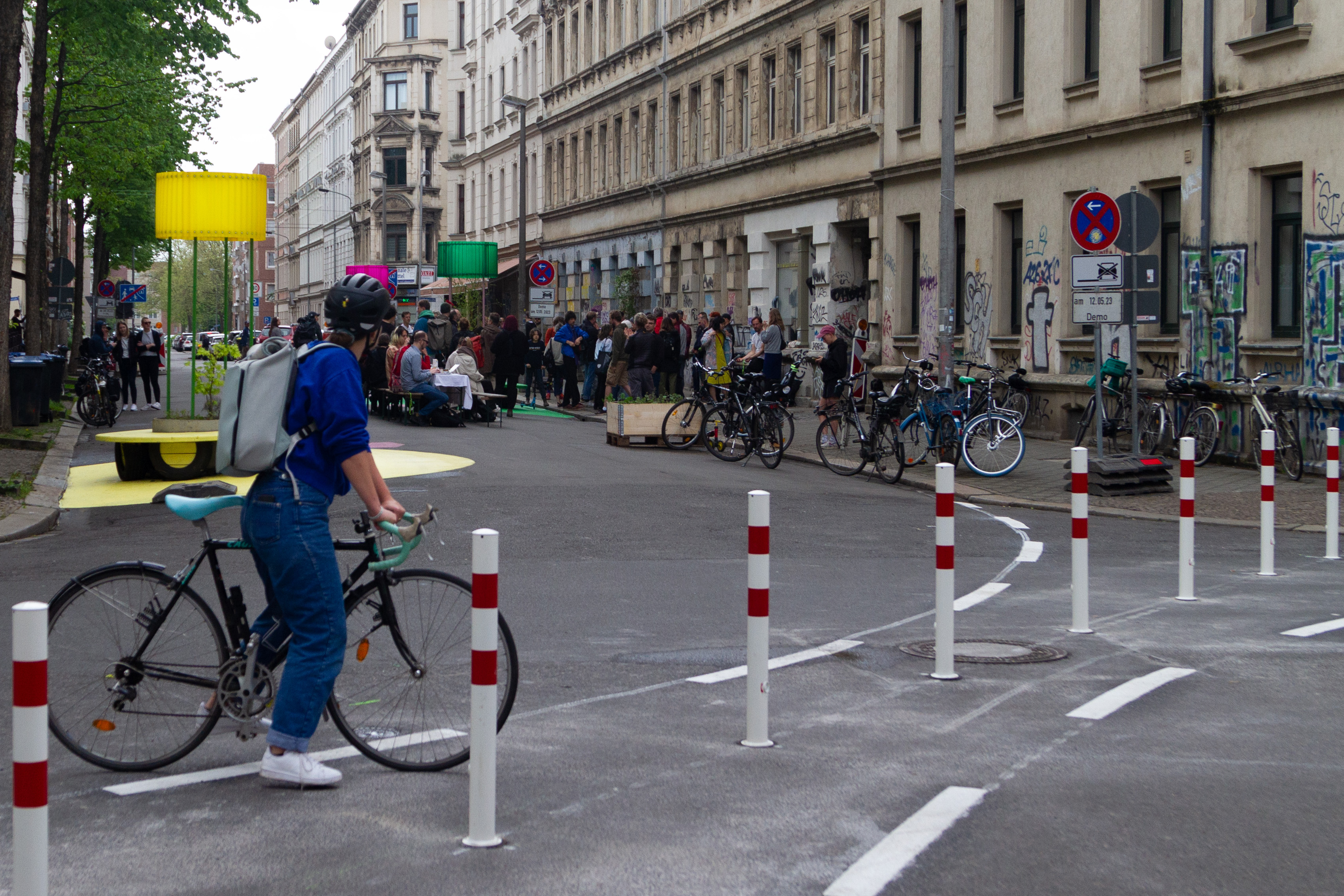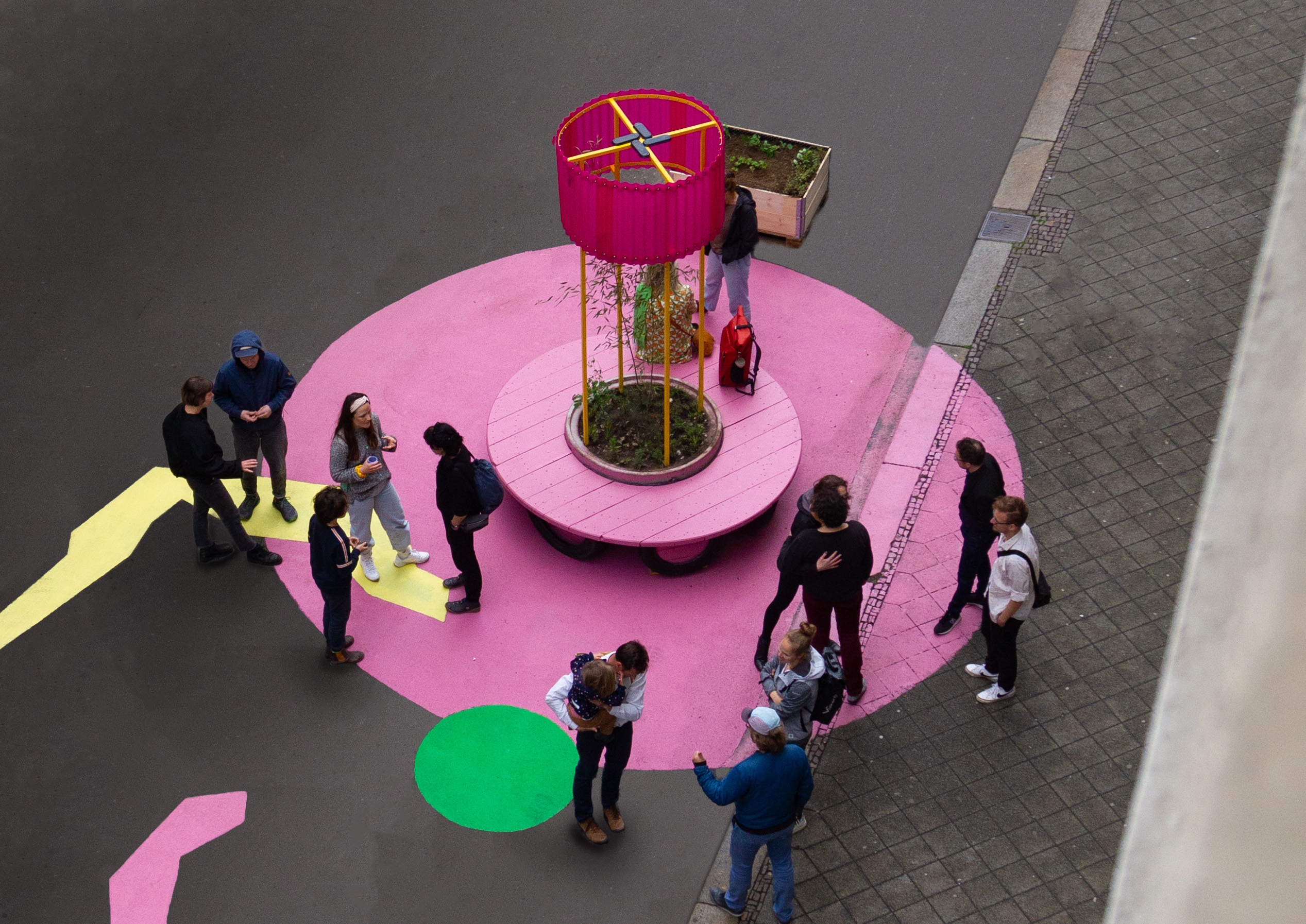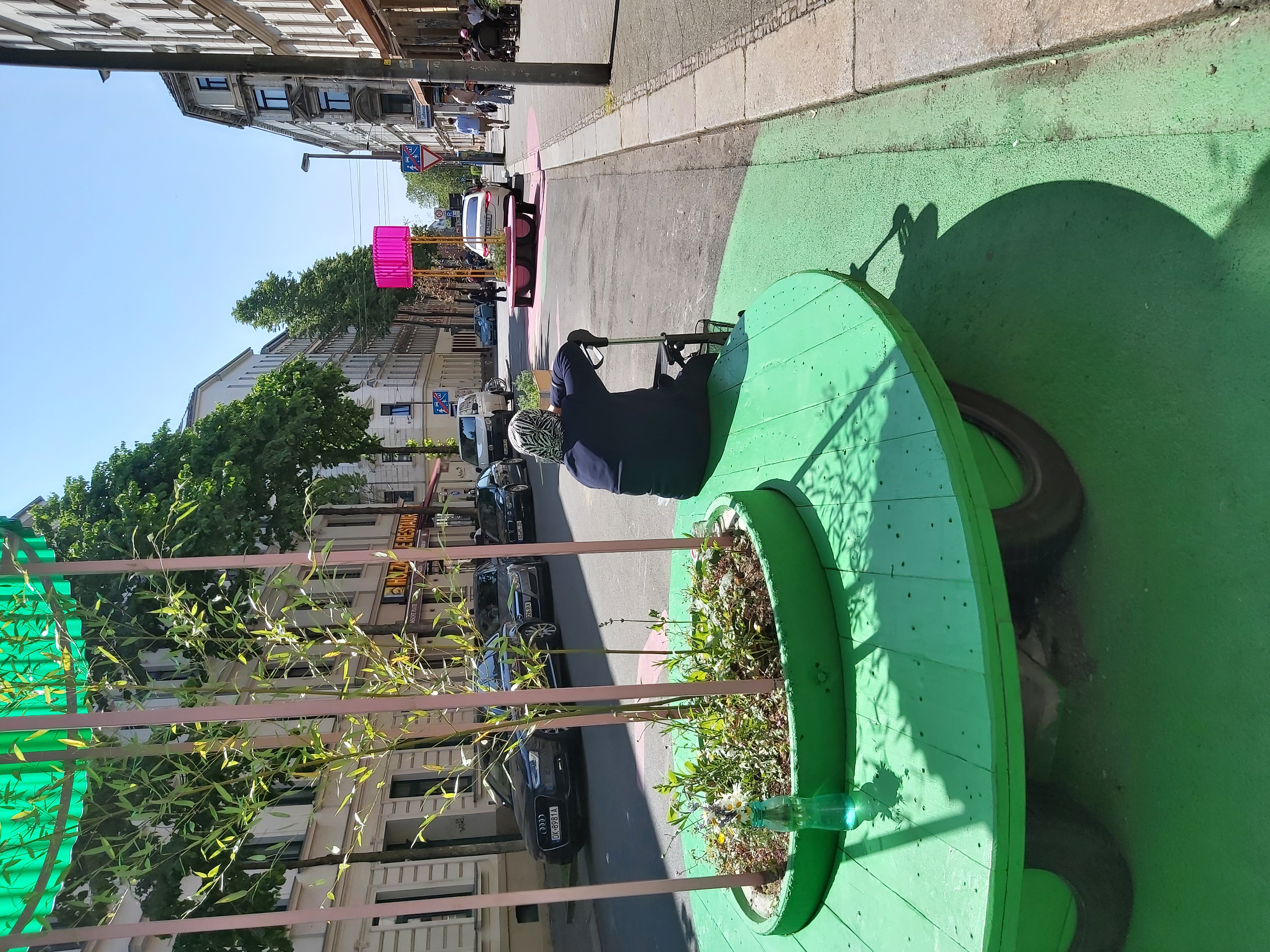Prioritising the places and people that need it the most
New Connections - Superblocks Leipzig
Experiment Superblocks in East Leipzig - Experiences from local co-production
The pilot project transformed streets into neighborhood hubs with fewer cars and more social interaction. In a diverse district, it showcased how urban spaces can prioritize people and sustainable mobility. A collaborative effort between civil society, city administration, policymakers, and researchers made sustainable urban development a tangible reality. The project’s ideas shaped a new traffic concept, officially approved in April 2024, which will now be implemented with public participation.
Germany
Local
Leipzig
Mainly urban
It refers to a physical transformation of the built environment (hard investment)
Yes
2024-05-31
No
No
No
As a representative of an organisation
"New Connections – Superblocks Leipzig" reimagines public streets as inclusive, people-centered spaces. Inspired by Barcelona’s Superblock concept, the project transforms urban streets into places of social interaction, participation, and sustainable mobility. In a densely built neighborhood with a diverse migration history, streets became vibrant hubs for community life, fostering exchange, recreation, and belonging.
The project directly tackles key urban challenges: limited participation, a lack of green spaces, and unsafe pathways. The Eisenbahnstraße area is often stigmatized as unsafe, but "New Connections – Superblocks Leipzig" shifts the perspective: it is not the people but the built environment that creates insecurity. By redesigning streets, the project establishes safe, welcoming spaces that enhance urban quality of life.
Sustainability: Less car traffic, more room for people – the project reduces motorized transport while promoting eco-friendly mobility. Streets have been redesigned as green, climate-adaptive spaces that increase safety and biodiversity.
Aesthetics & Cultural Experience: Public spaces serve as creative platforms for art and participation, with design interventions and temporary installations enhancing the urban landscape.
Inclusion & Social Justice: Children, people with disabilities, and marginalized communities actively contributed to shaping their environment, strengthening democratic participation. To counteract displacement, the project collaborated with the Helmholtz Centre for Environmental Research (UFZ) to develop socially just solutions that support long-standing residents.
By offering a replicable model for equitable urban development, the project has informed policy changes. Its outcomes contributed to Leipzig’s new mobility plan, officially adopted in April 2024 – a significant milestone in the transformation of public spaces into more inclusive and sustainable environments.
The project directly tackles key urban challenges: limited participation, a lack of green spaces, and unsafe pathways. The Eisenbahnstraße area is often stigmatized as unsafe, but "New Connections – Superblocks Leipzig" shifts the perspective: it is not the people but the built environment that creates insecurity. By redesigning streets, the project establishes safe, welcoming spaces that enhance urban quality of life.
Sustainability: Less car traffic, more room for people – the project reduces motorized transport while promoting eco-friendly mobility. Streets have been redesigned as green, climate-adaptive spaces that increase safety and biodiversity.
Aesthetics & Cultural Experience: Public spaces serve as creative platforms for art and participation, with design interventions and temporary installations enhancing the urban landscape.
Inclusion & Social Justice: Children, people with disabilities, and marginalized communities actively contributed to shaping their environment, strengthening democratic participation. To counteract displacement, the project collaborated with the Helmholtz Centre for Environmental Research (UFZ) to develop socially just solutions that support long-standing residents.
By offering a replicable model for equitable urban development, the project has informed policy changes. Its outcomes contributed to Leipzig’s new mobility plan, officially adopted in April 2024 – a significant milestone in the transformation of public spaces into more inclusive and sustainable environments.
Superblocks
Mobility Transition
Resilience
Sustainability
Participation
The project actively promotes the reduction of private motorized transport and strengthens sustainable, alternative mobility solutions. By transforming street spaces, green, livable areas have been created, improving climate resilience, biodiversity, and air quality. Circular economy principles are applied by repurposing existing materials and spaces to create high-quality public areas.
Beyond ecological aspects, the project significantly enhances residents' health. Reduced air pollutants and fine dust improve respiratory health, while traffic-calmed, green spaces lower noise levels and foster social interactions — essential for mental well-being. Encouraging walking and cycling increases daily physical activity, supporting an active and healthy urban lifestyle. Green infrastructure and permeable surfaces help mitigate urban heat, which is especially beneficial for vulnerable groups such as children and older people.
A key focus was on how civil society actors can initiate and shape urban transformation processes on an equal footing. This was analyzed in collaboration with the Helmholtz Centre for Environmental Research (UFZ), ensuring that sustainable urban development measures contribute to long-term social justice. The issue of green gentrification was also considered, with further research integrated into UFZ projects. The goal is to create sustainable improvements without displacing long-term residents.
Additionally, the project promotes sustainability through knowledge transfer and innovation. By testing and adapting successful approaches from other European cities, it demonstrates how international best practices can be implemented at the neighborhood level. The results contributed to Leipzig’s new mobility concept, officially adopted in April 2024, marking a significant step toward a socially and ecologically just urban transformation.
Beyond ecological aspects, the project significantly enhances residents' health. Reduced air pollutants and fine dust improve respiratory health, while traffic-calmed, green spaces lower noise levels and foster social interactions — essential for mental well-being. Encouraging walking and cycling increases daily physical activity, supporting an active and healthy urban lifestyle. Green infrastructure and permeable surfaces help mitigate urban heat, which is especially beneficial for vulnerable groups such as children and older people.
A key focus was on how civil society actors can initiate and shape urban transformation processes on an equal footing. This was analyzed in collaboration with the Helmholtz Centre for Environmental Research (UFZ), ensuring that sustainable urban development measures contribute to long-term social justice. The issue of green gentrification was also considered, with further research integrated into UFZ projects. The goal is to create sustainable improvements without displacing long-term residents.
Additionally, the project promotes sustainability through knowledge transfer and innovation. By testing and adapting successful approaches from other European cities, it demonstrates how international best practices can be implemented at the neighborhood level. The results contributed to Leipzig’s new mobility concept, officially adopted in April 2024, marking a significant step toward a socially and ecologically just urban transformation.
The project's aesthetics are deeply connected to its temporary and experimental nature. Instead of a fixed, unchangeable design, it intentionally creates an adaptable space that invites participation. Streets were reimagined with simple yet effective elements — colored markings, seating, and greenery — demonstrating that urban transformation is not solely the task of city administrations but can also emerge from civil society initiatives.
This approach fosters not only functionality but also cultural enrichment. The design encourages social interactions and strengthens the neighborhood’s connection to its environment. Temporary installations serve as a visible testing ground for long-term urban changes, illustrating that city-making is an evolving process where many can take part.
Additionally, the project sheds light on often overlooked urban policy dynamics, such as the voluntary relocation of families due to urban transformation. Cultural formats and discussions on issues like Green Gentrification highlighted these complexities: While improvements can lead to rising rents, they also contribute to more stable living conditions — particularly in terms of traffic safety for children. When public spaces become safer, fewer families feel pressured to move to suburban areas, which in turn helps prevent displacement-driven rent increases.
Since rent control measures — such as rent caps, social preservation statutes, and environmental protection policies — primarily safeguard existing rental agreements, they are most effective when fewer residents are forced to leave their central neighborhoods. In this way, a functional aesthetic that enhances safety and order in public spaces can ultimately generate broader social and ecological benefits.
This approach fosters not only functionality but also cultural enrichment. The design encourages social interactions and strengthens the neighborhood’s connection to its environment. Temporary installations serve as a visible testing ground for long-term urban changes, illustrating that city-making is an evolving process where many can take part.
Additionally, the project sheds light on often overlooked urban policy dynamics, such as the voluntary relocation of families due to urban transformation. Cultural formats and discussions on issues like Green Gentrification highlighted these complexities: While improvements can lead to rising rents, they also contribute to more stable living conditions — particularly in terms of traffic safety for children. When public spaces become safer, fewer families feel pressured to move to suburban areas, which in turn helps prevent displacement-driven rent increases.
Since rent control measures — such as rent caps, social preservation statutes, and environmental protection policies — primarily safeguard existing rental agreements, they are most effective when fewer residents are forced to leave their central neighborhoods. In this way, a functional aesthetic that enhances safety and order in public spaces can ultimately generate broader social and ecological benefits.
The project prioritizes inclusive urban development by actively involving diverse social groups in the planning process. Children, people with disabilities, families, women, and local businesses were intentionally integrated into the design of public spaces. This provided a platform for those who previously felt unheard, enabling them to co-create their environment and participate in decision-making.
This participatory approach strengthens democratic engagement and social cohesion while dismantling spatial and social barriers. Special attention was given to ensuring that neighborhood improvements do not lead to displacement but rather contribute to long-term stability. Urban resilience depends on a city's ability to adapt to change while preserving its social fabric.
A key focus was fostering a lasting social mix and sustainable neighborhood development. By making public spaces safer, more accessible, and functional, the project encouraged broad participation. This not only created new opportunities for engagement but also fostered sustainable social structures. These structures form the foundation for resilient neighborhoods, where residents can remain independent of external crises or gentrification pressures while actively shaping their city’s future.
This participatory approach strengthens democratic engagement and social cohesion while dismantling spatial and social barriers. Special attention was given to ensuring that neighborhood improvements do not lead to displacement but rather contribute to long-term stability. Urban resilience depends on a city's ability to adapt to change while preserving its social fabric.
A key focus was fostering a lasting social mix and sustainable neighborhood development. By making public spaces safer, more accessible, and functional, the project encouraged broad participation. This not only created new opportunities for engagement but also fostered sustainable social structures. These structures form the foundation for resilient neighborhoods, where residents can remain independent of external crises or gentrification pressures while actively shaping their city’s future.
The project is rooted in self-organization: The team emerged directly from the neighborhood to address social space challenges in a co-productive way. It consistently relies on participatory processes, enabling residents and local groups to actively shape public spaces. This democratization of urban space strengthens the sense of community and amplifies voices that were previously unheard.
By involving residents as co-creators rather than passive beneficiaries, the project fosters a deeper identification with the living environment. This strengthens social cohesion and enhances urban resilience — not just ecologically and economically, but also socially. Open and inclusive participation structures ensure that neighborhood development is not a top-down process but a shared endeavor.
Workshops, surveys, and multilingual discussion forums enabled broad and diverse participation. Residents, local stakeholders, and even passersby played a crucial role in shaping the project. As a result, improvements go beyond surface-level changes, leading to lasting social and ecological transformations — driven and sustained by the community itself.
In recognition of its impact, the project was awarded the first Saxon Participation Prize in 2024.
By involving residents as co-creators rather than passive beneficiaries, the project fosters a deeper identification with the living environment. This strengthens social cohesion and enhances urban resilience — not just ecologically and economically, but also socially. Open and inclusive participation structures ensure that neighborhood development is not a top-down process but a shared endeavor.
Workshops, surveys, and multilingual discussion forums enabled broad and diverse participation. Residents, local stakeholders, and even passersby played a crucial role in shaping the project. As a result, improvements go beyond surface-level changes, leading to lasting social and ecological transformations — driven and sustained by the community itself.
In recognition of its impact, the project was awarded the first Saxon Participation Prize in 2024.
The project is based on close collaboration between various stakeholders — ranging from residents and cultural and social initiatives to local businesses, municipal authorities, and urban planners. This multidimensional approach ensures that diverse perspectives contribute to urban development and that solutions address both social and environmental challenges.
Particularly noteworthy is the role of art and culture in transforming public spaces. Creative forms of expression are deliberately used to foster new dialogues, strengthen social connections, and further develop the neighborhood as a shared living space. This cultural and social participation not only enhances residents' identification with their district but also contributes to resilient urban development, creating long-term stability.
By actively involving these stakeholders, sustainable networks emerge that extend beyond individual projects. This ensures that transformation is not seen as a one-time intervention, but as an ongoing, collaboratively shaped process that can flexibly adapt to the needs of both people and the environment.
The close cooperation between civil society, city administration, and academia was key to the project's success. The city of Leipzig actively supported the initiative, while academic experts evaluated the measures taken.
Particularly noteworthy is the role of art and culture in transforming public spaces. Creative forms of expression are deliberately used to foster new dialogues, strengthen social connections, and further develop the neighborhood as a shared living space. This cultural and social participation not only enhances residents' identification with their district but also contributes to resilient urban development, creating long-term stability.
By actively involving these stakeholders, sustainable networks emerge that extend beyond individual projects. This ensures that transformation is not seen as a one-time intervention, but as an ongoing, collaboratively shaped process that can flexibly adapt to the needs of both people and the environment.
The close cooperation between civil society, city administration, and academia was key to the project's success. The city of Leipzig actively supported the initiative, while academic experts evaluated the measures taken.
The project integrates urban planning, mobility research, sociology, arts and culture, architecture, environmental sciences, social work, economics, democracy education, cultural education, and education for sustainable development in a holistic approach. This interdisciplinary collaboration led to innovative solutions that equally consider ecological, social, economic, and cultural aspects.
By bringing together experts from different fields, the project was able to address both the structural and social dimensions of urban development. Mobility research provided insights into how sustainable transportation infrastructure can enhance social participation. Social scientists analyzed the impact on different population groups, while artists and cultural practitioners developed creative methods to foster democratic participation and civic engagement.
A particular added value emerged from the connection between cultural education and education for sustainable development: participatory formats allowed local residents not only to take part in the design process but also to learn about sustainable urban development and actively contribute their perspectives. This strengthened democratic processes and promoted a fairer distribution of resources and decision-making power.
Economic actors were also involved to support a socially inclusive and sustainable urban development. Collaborations with local businesses helped generate economic impulses for the neighborhood without reinforcing social displacement.
Overall, the project serves as an exemplary model of how citizen participation, interdisciplinary cooperation, and the involvement of diverse stakeholders can create long-term, livable, just, and future-oriented urban spaces.
By bringing together experts from different fields, the project was able to address both the structural and social dimensions of urban development. Mobility research provided insights into how sustainable transportation infrastructure can enhance social participation. Social scientists analyzed the impact on different population groups, while artists and cultural practitioners developed creative methods to foster democratic participation and civic engagement.
A particular added value emerged from the connection between cultural education and education for sustainable development: participatory formats allowed local residents not only to take part in the design process but also to learn about sustainable urban development and actively contribute their perspectives. This strengthened democratic processes and promoted a fairer distribution of resources and decision-making power.
Economic actors were also involved to support a socially inclusive and sustainable urban development. Collaborations with local businesses helped generate economic impulses for the neighborhood without reinforcing social displacement.
Overall, the project serves as an exemplary model of how citizen participation, interdisciplinary cooperation, and the involvement of diverse stakeholders can create long-term, livable, just, and future-oriented urban spaces.
The project demonstrates how temporary measures can initiate long-term urban development processes. By combining scientific research, bottom-up participation, and temporary interventions, it has created an innovative model for urban resilience. The artistic and cultural approach played a key role: it ensured low-threshold access, promoted broad participation, and connected informal and formal engagement formats. The focus on mobility served as a catalyst for rethinking social spaces and expanding public involvement.
A central innovation was the transdisciplinary collaboration: urban planning, mobility research, social sciences, arts and culture, education, social innovation, and environmental sciences were integrated to develop both a practical and visionary process. Unlike conventional top-down planning, the project created an open experimental space where citizens, researchers, and city administrations jointly tested and refined new models.
A key strength of the project was its adaptive strategy. Iterative processes and continuous feedback loops allowed for flexible adjustments based on the actual needs of the community. This dynamic approach prevented rigid structures and fostered sustainable changes that align with people’s daily lives.
Furthermore, the project contributed to the democratization of urban development. While traditional planning approaches often reinforce existing power structures, this initiative redistributed decision-making power more equitably. Through participatory methods such as co-design workshops, artistic interventions, and digital engagement tools, a diverse range of voices — especially those that are often unheard — were actively included.
Overall, the project serves as an exemplary model of community-driven, sustainable, and participatory urban development. It goes beyond superficial changes and enables deep social, ecological, and economic transformations.
A central innovation was the transdisciplinary collaboration: urban planning, mobility research, social sciences, arts and culture, education, social innovation, and environmental sciences were integrated to develop both a practical and visionary process. Unlike conventional top-down planning, the project created an open experimental space where citizens, researchers, and city administrations jointly tested and refined new models.
A key strength of the project was its adaptive strategy. Iterative processes and continuous feedback loops allowed for flexible adjustments based on the actual needs of the community. This dynamic approach prevented rigid structures and fostered sustainable changes that align with people’s daily lives.
Furthermore, the project contributed to the democratization of urban development. While traditional planning approaches often reinforce existing power structures, this initiative redistributed decision-making power more equitably. Through participatory methods such as co-design workshops, artistic interventions, and digital engagement tools, a diverse range of voices — especially those that are often unheard — were actively included.
Overall, the project serves as an exemplary model of community-driven, sustainable, and participatory urban development. It goes beyond superficial changes and enables deep social, ecological, and economic transformations.
The project methodology was based on an interdisciplinary, participatory, and experimental approach that actively involved diverse stakeholders and addressed social and ecological challenges.
Participatory Planning and Co-Creation
Local residents, organizations, and social groups were engaged early in the process. Workshops and forums enabled citizens to contribute their needs and ideas, while artistic interventions enhanced public engagement and cultural value.
Inclusive and Interdisciplinary Collaboration
Urban planners, mobility researchers, sociologists, artists, and environmental organizations developed holistic solutions. Local businesses and social institutions supported long-term implementation, with special attention to marginalized groups.
Experimental Public Space Design
Temporary interventions (e.g., pop-ups, mobile urban furniture) tested concepts before permanent implementation. Living Labs allowed continuous adaptation and optimization.
Sustainability and Ecological Principles
Traffic-calming reduced CO₂ emissions and improved air quality. Greening and rainwater management enhanced climate resilience, while circular economy principles promoted sustainable materials and upcycling.
Strengthening Social Cohesion
Dialogue-based events fostered inclusion and multilingual exchange. Conflicts were acknowledged and addressed as part of the urban development process.
Continuous Reflection and Evaluation
Scientific research and iterative adjustments ensured long-term impact, with sustainable effects measured over time.
By integrating participation, inclusion, sustainability, interdisciplinary collaboration, and experimentation, the project established an innovative model for more just and resilient urban development.
Participatory Planning and Co-Creation
Local residents, organizations, and social groups were engaged early in the process. Workshops and forums enabled citizens to contribute their needs and ideas, while artistic interventions enhanced public engagement and cultural value.
Inclusive and Interdisciplinary Collaboration
Urban planners, mobility researchers, sociologists, artists, and environmental organizations developed holistic solutions. Local businesses and social institutions supported long-term implementation, with special attention to marginalized groups.
Experimental Public Space Design
Temporary interventions (e.g., pop-ups, mobile urban furniture) tested concepts before permanent implementation. Living Labs allowed continuous adaptation and optimization.
Sustainability and Ecological Principles
Traffic-calming reduced CO₂ emissions and improved air quality. Greening and rainwater management enhanced climate resilience, while circular economy principles promoted sustainable materials and upcycling.
Strengthening Social Cohesion
Dialogue-based events fostered inclusion and multilingual exchange. Conflicts were acknowledged and addressed as part of the urban development process.
Continuous Reflection and Evaluation
Scientific research and iterative adjustments ensured long-term impact, with sustainable effects measured over time.
By integrating participation, inclusion, sustainability, interdisciplinary collaboration, and experimentation, the project established an innovative model for more just and resilient urban development.
The Superblock concept is adaptable and can be replicated in other cities, neighborhoods, and contexts. The combination of temporary artistic interventions, citizen participation, and scientific support provides a flexible methodology for various urban settings.
Unlike the original top-down model from Barcelona, the Leipzig project follows a more inclusive and co-productive approach. The local community led the process, ensuring alignment with local needs and aspirations. This community-driven transformation of public space offers a replicable model for fostering local engagement and resilient urban change.
Non-formal participation formats and online surveys were integrated with formal decision-making processes. Engaging business owners through hearings, readings, and council meetings helped to legitimize the traffic concept and integrate it into official structures.
Key elements for replication include:
- Single-day traffic trials that allowed residents to directly experience and evaluate potential interventions.
- A year-long traffic trial in a side street, assessing the long-term impact of traffic-calming measures.
- A mobile 'Wunschbüro' (engagement unit) that brought participatory processes directly to residents, gathering ideas and feedback.
- Mitmachforen (participatory forums) and Straßenschule (street school), fostering cross-sectoral collaboration on cultural, mobility, and environmental topics.
- Integration with the official participatory processes of the City of Leipzig, ensuring alignment with municipal strategies and institutional backing.
The project's success was built on a bottom-up approach, initiated by residents and supported by an association, which facilitated broad participation and garnered strong local support. Funding from the National Urban Development Policy program 'Post-Corona City' ensured both the implementation and the long-term sustainability of the project, making this approach applicable and scalable.
Unlike the original top-down model from Barcelona, the Leipzig project follows a more inclusive and co-productive approach. The local community led the process, ensuring alignment with local needs and aspirations. This community-driven transformation of public space offers a replicable model for fostering local engagement and resilient urban change.
Non-formal participation formats and online surveys were integrated with formal decision-making processes. Engaging business owners through hearings, readings, and council meetings helped to legitimize the traffic concept and integrate it into official structures.
Key elements for replication include:
- Single-day traffic trials that allowed residents to directly experience and evaluate potential interventions.
- A year-long traffic trial in a side street, assessing the long-term impact of traffic-calming measures.
- A mobile 'Wunschbüro' (engagement unit) that brought participatory processes directly to residents, gathering ideas and feedback.
- Mitmachforen (participatory forums) and Straßenschule (street school), fostering cross-sectoral collaboration on cultural, mobility, and environmental topics.
- Integration with the official participatory processes of the City of Leipzig, ensuring alignment with municipal strategies and institutional backing.
The project's success was built on a bottom-up approach, initiated by residents and supported by an association, which facilitated broad participation and garnered strong local support. Funding from the National Urban Development Policy program 'Post-Corona City' ensured both the implementation and the long-term sustainability of the project, making this approach applicable and scalable.
The project addresses global challenges such as climate change, social inequality, and the overuse of urban spaces by providing innovative, local, and participatory solutions. It not only creates tangible changes in urban areas but also fosters discourse that makes complex concepts of urban planning and sustainable development more accessible. In doing so, it tackles current challenges, shares knowledge on best practices, and strengthens networking efforts for broader impact.
By reducing motorized individual traffic and promoting sustainable mobility, the project helps lower CO₂ emissions and supports the city's climate adaptation efforts. It achieves local environmental goals while contributing to global initiatives focused on creating a more sustainable future. Through integrating green spaces and implementing rainwater management measures, the project fosters a climate-resilient urban environment that enhances quality of life and promotes biodiversity.
A core aim of the project is to advance social justice by involving marginalized groups — such as migrants, people with disabilities, children, youth, women, and families — in urban design. By prioritizing inclusive planning and democratic participation, the project addressed social inequalities, ensuring a fairer distribution of urban resources and empowering these groups in decision-making processes.
The initiative demonstrates how local actions can effectively tackle global issues like climate change and social inequality through participatory, interdisciplinary approaches. These local solutions offer scalable models for other cities, highlighting the power of civic engagement in achieving sustainable urban development. In March 2025, our organisation will present at the EU-funded UPRUN (Urban Planning for Social Resilience in Urban Neighborhoods. Transformative Change through Civic Engagement) conference in Skopje.
By reducing motorized individual traffic and promoting sustainable mobility, the project helps lower CO₂ emissions and supports the city's climate adaptation efforts. It achieves local environmental goals while contributing to global initiatives focused on creating a more sustainable future. Through integrating green spaces and implementing rainwater management measures, the project fosters a climate-resilient urban environment that enhances quality of life and promotes biodiversity.
A core aim of the project is to advance social justice by involving marginalized groups — such as migrants, people with disabilities, children, youth, women, and families — in urban design. By prioritizing inclusive planning and democratic participation, the project addressed social inequalities, ensuring a fairer distribution of urban resources and empowering these groups in decision-making processes.
The initiative demonstrates how local actions can effectively tackle global issues like climate change and social inequality through participatory, interdisciplinary approaches. These local solutions offer scalable models for other cities, highlighting the power of civic engagement in achieving sustainable urban development. In March 2025, our organisation will present at the EU-funded UPRUN (Urban Planning for Social Resilience in Urban Neighborhoods. Transformative Change through Civic Engagement) conference in Skopje.
The project has significantly improved the quality of life in Leipzig’s east.
Reduced Traffic & Increased Safety: The noticeable reduction in through traffic has improved traffic flow, particularly enhancing safety for children, the elderly, and people with disabilities. The streets are now safer for pedestrians and cyclists, contributing to a better overall quality of life.
Improved Quality of Life & Social Interaction: By transforming streets into green, accessible spaces, more people are spending time outdoors. This revitalization has strengthened social bonds. Public spaces are now being used for socializing, community events, and recreational activities, fostering a more vibrant and connected community.
Citizen Participation & Social Inclusion: One of the key outcomes is the active involvement of marginalized groups, such as children, the elderly, migrants, and people with disabilities, in shaping public spaces. This participatory approach promotes democratic engagement, strengthens social cohesion, and addresses inequalities by giving groups a voice in urban design.
Sustainable Urban Development: The project prioritizes sustainable mobility options, such as cycling and public transport, contributing to a climate-friendly, health-promoting urban structure. Furthermore, the low cost of implementing these changes makes them accessible for other cities.
Replicable Model: A handbook is being published to guide other municipalities in replicating the model. This document will be presented in late April at the Deutsches Architekturmuseum (DAM).
Evaluation & Feedback: Evaluation reports and participant feedback confirm the success of the project. These insights are crucial for refining the approach and ensuring its adaptability to other contexts.
Overall, "the project demonstrates that participatory, sustainable urban development not only benefits the environment but also enhances public health and strengthens social and democratic ties.
Reduced Traffic & Increased Safety: The noticeable reduction in through traffic has improved traffic flow, particularly enhancing safety for children, the elderly, and people with disabilities. The streets are now safer for pedestrians and cyclists, contributing to a better overall quality of life.
Improved Quality of Life & Social Interaction: By transforming streets into green, accessible spaces, more people are spending time outdoors. This revitalization has strengthened social bonds. Public spaces are now being used for socializing, community events, and recreational activities, fostering a more vibrant and connected community.
Citizen Participation & Social Inclusion: One of the key outcomes is the active involvement of marginalized groups, such as children, the elderly, migrants, and people with disabilities, in shaping public spaces. This participatory approach promotes democratic engagement, strengthens social cohesion, and addresses inequalities by giving groups a voice in urban design.
Sustainable Urban Development: The project prioritizes sustainable mobility options, such as cycling and public transport, contributing to a climate-friendly, health-promoting urban structure. Furthermore, the low cost of implementing these changes makes them accessible for other cities.
Replicable Model: A handbook is being published to guide other municipalities in replicating the model. This document will be presented in late April at the Deutsches Architekturmuseum (DAM).
Evaluation & Feedback: Evaluation reports and participant feedback confirm the success of the project. These insights are crucial for refining the approach and ensuring its adaptability to other contexts.
Overall, "the project demonstrates that participatory, sustainable urban development not only benefits the environment but also enhances public health and strengthens social and democratic ties.

